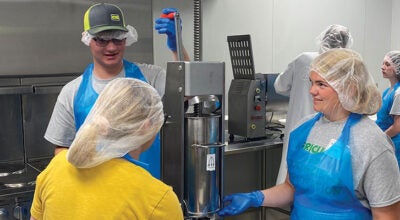CRWD projects aim to slow the flow
Published 10:08 am Thursday, August 27, 2015
With $6.4 million to improve water quality and reduce flooding on the Cedar River and Dobbins Creek, Cedar River Watershed District leaders are getting ready to flow into big projects.
In a way, it will be business as usual, taking on projects that reduce water flow by retaining water during large flood events. However, the $3.2 million Hormel Foundation grant, which CRWD is matching, will help CRWD complete 25 projects through the Accelerated Results Plan, which takes its work to an enhanced scale with a bigger impact.
By slowing water flow through the 25 projects, the CRWD will be able to track projects and see significant benefits.
“If you can reduce the flows coming through Austin and through the rest of the system then you’re going to have better water quality as well,” CRWD Resource Specialist Justin Hanson said.
Dobbins Creek and the Cedar River are listed by the state as “impaired” for aquatic life and turbidity, which relates to the water being muddy or cloudy.
The plan announced Wednesday aims to reduce the level of flood flows, downstream erosion and storm water runoff from reaching waterways. It also will restore wetlands and stabilize river ravines. Most of the projects will include water retention or detention areas.
During most flooding events, water on the Cedar and Dobbins will get almost a Hershey, chocolate brown, according to Hanson. During Wednesday’s announcement of the foundation grant, Hanson pointed to clear water where the two waterways converge.
“Those big flood events are the ones that really deliver a ton of sediment, a ton of dirt,” he said.
Hanson compared the flood events to a wave in that it has energy. When it goes through the water system, it takes dirt and sediment with it.
“What we’re trying to do is take that wave out of the system,” he said. “By doing that, very simply, you take that energy out and we keep a lot of the soil on the land and out of the river.”
In a 4-inch rain event, about 100 truckloads of sediment and dirt are dumped into East Side Lake, and Hanson referenced chronic flooding in Interstate 90 near the lake.
Most of the 25 sites are targeted in the Dobbins Creek subwatershed due to the flash-flooding nature of the creek. Two Dobbins Creek branches meet in Austin’s Jay C. Hormel Nature Center before forming East Side Lake due to a dam.
CRWD studies have shown Dobbins to be a major contributor to Austin’s flooding and downstream sedimentation. The new initiative’s work will lay a strong foundation for the community’s long-term goal of making East Side Lake a better recreational resource, according to Hanson.
Hanson said they face challenges on the Cedar. The river’s headwaters are in Dodge County. After flowing through Mower County and Austin, where Turtle and Dobbins creeks join it, the river flows through Iowa to join the Iowa River in Louisa County and eventually the Mississippi River.
The roughly 11-mile stretch from the headwaters to the confluence of the Cedar and Dobbins accounts for 17 percent of the grade and change in elevation from the Cedar’s headwaters to the Gulf of Mexico.
“We have challenges in this area,” Hanson said.
Sites for the 25 Accelerated Results Plan projects were determined through a hydro-engineering study funded by CRWD to determine areas in the watershed where investment would leverage the most results.
CRWD is ready to start construction on projects in spring 2016 under the new plan and will conduct extensive monitoring in the coming years to measure water-quality results.
Costs in the five-year Accelerated Results Plan include engineering, project management, construction and staffing. The other funding is expected to come from CRWD’s reserves and operating levy as well as from the state of Minnesota. The Hormel Foundation’s grant will also increase the likelihood of CRWD being awarded highly competitive grants.
In 2014, CRWD launched a nearly $2.1 million project to restore the water quality of Dobbins Creek with state agencies and University of Minnesota students. That project included a $1.5 million state grant and $100,000 grant from The Hormel Foundation. The CRWD recently won a $500,000 federal grant through the Natural Resource Conservation Service.
Taken together, the three projects will invest $9 million into improving the quality of water in the area over the next five years.




